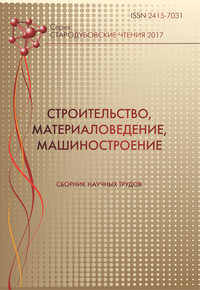Effect of hardening technology reinforcement bars strength class 500 mpa on the characteristics of its firedurability
Keywords:
reinforcement bars, technology, temperature, heat, strength, fire safety, the type of defects in the crystalline structureAbstract
Annotation. Purpose. Investigating the strength properties of the samples of products subjected to heating and subsequent cooling (thermal action under fire conditions), a comparative analysis of the fire safety of the 500MPa reinforcement bars produced by strengthening technologies: thermomechanical hardening, cold deformation and alloying. Methodology. The thermal effect in the fire conditions was simulated by heating the samples in the furnace to temperatures of 200, 300, 400, 450, 500, 550, 600, 700 and 800 ° C and holding for 1 hour followed by cooling. For comparative tests, the reinforcement bars specimens were used in the initial state, which were not subjected to heating. Testing of the tensile reinforcement specimens was carried out according to the normative documentation at room temperature with the recording of the deformation and fracture diagrams. Findings. It is established that the reinforcement of the strength class of 500 MPa, obtained by technologies that provide hardening by doping with manganese and silicon, by thermomechanical hardening from rolling heating and by cold deformation of the hot-worked billet, have practically identical fire-protection characteristics up to heating temperatures of 500-550 ° C. Originality. For the first time, the dependence of the intensity of softening of the reinforcement upon heating above 500 ... 550 ° С on the preferential type of defects of the crystalline structure, the increase in the concentration of which gives the effect of hardening. Practicalvalue. Increase in the use of colddeformed reinforcing bars of strength class V500C in construction.References
EN 1992–1–2:2004. Eurocode 2: Design of concrete structures. Part 1–2: General rules – Structural fire design. – Brussels, 2004.
SRT 36554501-006-2006. Pravila po obespecheniyu ognestoykosti i ognesokhrannosti zhelezobetonnykh konstruktsiy. [Rules for ensuring fire resistance and fire safety of reinforced concrete structures]. Moscow, JSC Research Center of Construction, 2006, 78 p.(in Russian).
Minregion Ukrainy. DSTU-N B EN 1992-1-2:2012. Yevrokod 2.Proyektuvannya zalizobetonnykh konstruktsiy.Chastyna 1-2. Zahalʹni polozhennya. Rozrakhunok konstruktsiy na vohnestiykist [State standard of Ukraine N B EN 1992-1-2:2012Eurocode 2: Design of concrete structures. Part 1–2: General rules. Calculation of fire resistance of structures.]Kyiv, 2012, 135 p. (in Ukrainian)
Nikolaou J., Papadimitriou G. D. Microstructures and mechanical properties after heating of reinforcing 500 MPa class weldable steels produced by various processes (Tempcore, microalloyed with vanadium and work-hardened) //Construction and Building Materials – 2004. – Т. 18. – №. 4. – С. 243-254.
Babych V. K., Gulʹ YU. P., Dolzhenkov Y. E. Deformatsyonnoe starenye staly[Strain ageing of steel] // Moscow: Metallurgiya [Metallurgy], 1972, 320 p.(in Russian).
Ivchenko A.V., Gul' YU.P., Pankov R.V., Kondratenko P.V. Ognesokhrannost' kholodnodeformirovannogo armaturnogo prokata klassa V500S [Fire safety of cold-formed reinforcing bars of class В500С] // Beton i zhelezobeton v Ukraine[Concrete and reinforced concrete in Ukraine]. – 2015. – V.5. – pp. 24-29. (in Russian).
Kuznetsova I.S., Surikov I.N., Vostrov M.S., Savrasov I.P. Issledovaniye fiziko-mekhanicheskikh svoystv armatury sovremennogo proizvodstva pri vysokotemperaturnom nagreve i okhlazhdenii [Investigation of the physical and mechanical properties of modern production fittings under high-temperature heating and cooling] // Promyshlennoye i grazhdanskoye stroitel'stvo [Industrial and civil construction]. - 2016. – V.12. – pp. 18-23.(inRussian).
Downloads
Published
Issue
Section
License
Редакція Видання категорично засуджує прояви плагіату в статтях та вживає всіх можливих заходів для його недопущення. Плагіат розглядається як форма порушення авторських прав і наукової етики.
При виявлені у статті більш ніж 25% запозиченого тексту без відповідних посилань та використання лапок, стаття кваліфікується як така, що містить плагіат. У цьому випадку стаття більше не розглядається редакцією, а автор отримує перше попередження.
Автори, в статтях яких повторно виявлено плагіат, не зможуть публікуватися в усіх журналах Видавництва ДВНЗ «Придніпровська державна академія будівництва та архітектури».
Автори, які публікуються у цьому журналі, погоджуються з наступними умовами:
- Автори залишають за собою право на авторство своєї роботи та передають журналу право першої публікації цієї роботи на умовах ліцензії Creative Commons Attribution License, котра дозволяє іншим особам вільно розповсюджувати опубліковану роботу з обов'язковим посиланням на авторів оригінальної роботи та першу публікацію роботи у цьому журналі.
- Автори мають право укладати самостійні додаткові угоди щодо неексклюзивного розповсюдження роботи у тому вигляді, в якому вона була опублікована цим журналом (наприклад, розміщувати роботу в електронному сховищі установи або публікувати у складі монографії), за умови збереження посилання на першу публікацію роботи у цьому журналі.
- Політика журналу дозволяє і заохочує розміщення авторами в мережі Інтернет (наприклад, у сховищах установ або на особистих веб-сайтах) рукопису роботи, як до подання цього рукопису до редакції, так і під час його редакційного опрацювання, оскільки це сприяє виникненню продуктивної наукової дискусії та позитивно позначається на оперативності та динаміці цитування опублікованої роботи (див. The Effect of Open Access).

